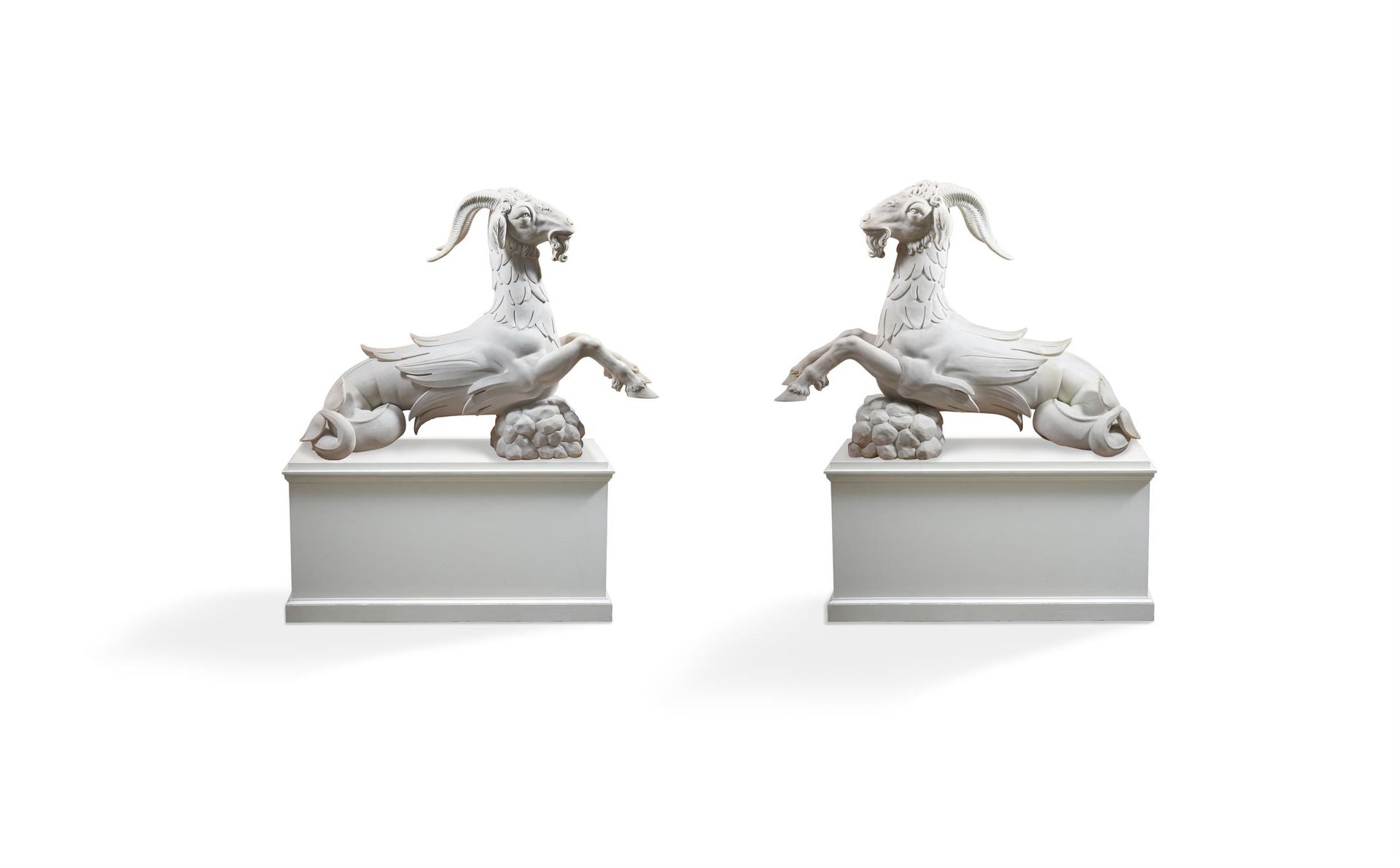Description
ATTRIBUTED INNOCENZO SPINAZZI (1726-1798), ITALIAN
ATTRIBUTED INNOCENZO SPINAZZI (1726-1798) ITALIAN, FLORENCE, CA. 1775 PAIR OF CAPRICORNS Marble each 115 by 154cm Provenance: With Giovanni Pratesi Antiquario, 2011 These outstanding marble Capricorns are exceptional for their size, quality and condition, as well as for the rarity of the subject matter in Italian sculpture. The model originates in 16th century Florence, created to decorate monumental gate posts in the Boboli Gardens, the famous park connected to the Palazzo Pitti. Attributed to a sculptor from the circle of Bartolomeo Ammannati (1511-1592), they flank the entrance to the Isola, a part of the gardens that has Giambologna's magisterial Oceanus fountain at its centre. The Capricorn was an important emblem for Cosimo I de' Medici (1519-1574), for whom the star sign was ascendant, and its use here may have been an homage to Lorenzo il Magnifico, the late 15th century Medici ruler, who was born on 1 January 1449, making him a Capricorn. By the middle of the 18th century, the Boboli Gardens had fallen into disrepair. With the arrival of the Lorrainese Grand Duke Pietro Leopoldo (later Emperor Leopold II) at Florence in 1770, a programme to restore the Gardens was initiated. The commission given to Innocenzo Spinazzi is documented between 1775-1777. The Roman sculptor was required to repair, copy and restore the sixteenth century Capricorns, which were eventually reinstalled in the Boboli Gardens. The Capricorns are the crowning achievement of Spinazzi's work in the Boboli Gardens project and this aspect of his career has been studied in depth by Prof. Gabriele Capecchi, who has written extensively on the Boboli Gardens and has authored a volume dedicated to these Capricorns that details all the related documents and to which the present text is indebted. Capecchi has published a series of documents issued by the Scrittoio della Fortezza e Fabbriche in the 1770s which relate to the programme of restoration in the Boboli Gardens. A document dated 27 January 1776 describes the Vasca detta dell'Isola that needed restoration to the sculptures, which included four Capricorns described as by Giambologna and his assistants; Capecchi attributes them to the circle of Ammannati, a contemporary of Giambologna. This document details how two of the statues had been delivered to Spinazzi's studio to be repaired and specifies that two casts were to be taken, from which four statues were required to be made. The documents go on to specify the high quality marble needed for these new copies which was to be brought directly from Carrara, because the quality of the existing marble in the warehouse at S. Lorenzo was inadequate. The documents note that Spinazzi was working on this commission with an assistant, Giuseppe Belli, and the plaster casts were made by the specialist craftsman, Niccolò Kindermann. By July 1777, the initial plan to replace the 16th century Capricorns with new ones was altered, presumably due to pressure of time and lack of funds, in favour of restoring the original marbles by adding new heads, horns and tails. The four restored statues were transported back to the Boboli Gardens and reinstalled on 26 August 1777. The present pair of marbles fit with the description of the Capricorns in these documents. It is apparent, however, that they vary in many details from the existing Capricorns in the Boboli Gardens. The carving of the hair on the heads, the anatomy of the mouths and the carving of the eyes are all different. It is notable that the tails differ between the four existing Capricorns in the Boboli Gardens, two having their tails pointing down and two pointing up. The present Capricorns are consistent with the latter. These inconsistencies bring into question which animals in the Boboli Gardens are the work of Spinazzi, Harwood and Capezzóli, and why the present marbles are different. In approaching the commission to restore and copy the Capricorns, Spinazzi brought a wealth of experience he had gained working with ancient sculpture in Rome, which had surely recommended him to the Grand Duke five years previously. Certainly, he was a skilled restorer of ancient Roman statues, and made exact, high quality copies. The Capricorns are of the same genre, but distinct in their animal subject matter. Here, his source is not Antiquity, but a 16th century model. In the late 18th century, the Boboli Capricorns were believed to be by the great Giambologna, whose sculptures were reproduced for the Grand Tourists with the same reverence afforded to antique marbles. It is natural, then, that Spinazzi would have approached his commission first to copy and then to restore the Capricorns with great respect to the originals. This may account for the clear differences between the heads of the Capricorns in the Boboli Gardens and the present pair: the eyes of the animals in situ are un-carved; the form of the snout and tail are different; the hair is depicted with shorter, more deeply carved curls; and the ha
280
ATTRIBUTED INNOCENZO SPINAZZI (1726-1798), ITALIAN
